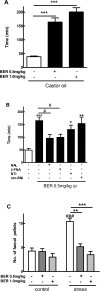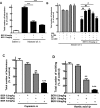Berberine Improves Intestinal Motility and Visceral Pain in the Mouse Models Mimicking Diarrhea-Predominant Irritable Bowel Syndrome (IBS-D) Symptoms in an Opioid-Receptor Dependent Manner
- PMID: 26700862
- PMCID: PMC4689480
- DOI: 10.1371/journal.pone.0145556
Berberine Improves Intestinal Motility and Visceral Pain in the Mouse Models Mimicking Diarrhea-Predominant Irritable Bowel Syndrome (IBS-D) Symptoms in an Opioid-Receptor Dependent Manner
Abstract
Background and aims: Berberine and its derivatives display potent analgesic, anti-inflammatory and anticancer activity. Here we aimed at characterizing the mechanism of action of berberine in the gastrointestinal (GI) tract and cortical neurons using animal models and in vitro tests.
Methods: The effect of berberine was characterized in murine models mimicking diarrhea-predominant irritable bowel syndrome (IBS-D) symptoms. Then the opioid antagonists were used to identify the receptors involved. Furthermore, the effect of berberineon opioid receptors expression was established in the mouse intestine and rat fetal cortical neurons.
Results: In mouse models, berberine prolonged GI transit and time to diarrhea in a dose-dependent manner, and significantly reduced visceral pain. In physiological conditions the effects of berberine were mediated by mu- (MOR) and delta- (DOR) opioid receptors; hypermotility, excessive secretion and nociception were reversed by berberine through MOR and DOR-dependent action. We also found that berberine increased the expression of MOR and DOR in the mouse bowel and rat fetal cortical neurons.
Conclusion: Berberine significantly improved IBS-D symptoms in animal models, possibly through mu- and delta- opioid receptors. Berberine may become a new drug candidate for the successful treatment of IBS-D in clinical conditions.
Conflict of interest statement
Figures





Similar articles
-
Methyl-orvinol-Dual activity opioid receptor ligand inhibits gastrointestinal transit and alleviates abdominal pain in the mouse models mimicking diarrhea-predominant irritable bowel syndrome.Pharmacol Rep. 2017 Apr;69(2):350-357. doi: 10.1016/j.pharep.2016.12.001. Epub 2016 Dec 5. Pharmacol Rep. 2017. PMID: 28187396 Free PMC article.
-
Mixed MOP/DOP agonist biphalin elicits anti-transit effect in mouse models mimicking diarrhea-predominant irritable bowel syndrome symptoms.Pharmacol Rep. 2016 Feb;68(1):32-6. doi: 10.1016/j.pharep.2015.06.001. Epub 2015 Jun 12. Pharmacol Rep. 2016. PMID: 26721348
-
Orally administered novel cyclic pentapeptide P-317 alleviates symptoms of diarrhoea-predominant irritable bowel syndrome.J Pharm Pharmacol. 2015 Feb;67(2):244-54. doi: 10.1111/jphp.12335. Epub 2014 Dec 17. J Pharm Pharmacol. 2015. PMID: 25515402
-
Eluxadoline for the treatment of diarrhoea-predominant irritable bowel syndrome.Expert Opin Pharmacother. 2016 Jul;17(10):1395-402. doi: 10.1080/14656566.2016.1182982. Epub 2016 Jun 8. Expert Opin Pharmacother. 2016. PMID: 27267380 Review.
-
Emerging treatments in neurogastroenterology: eluxadoline - a new therapeutic option for diarrhea-predominant IBS.Neurogastroenterol Motil. 2016 Jan;28(1):26-35. doi: 10.1111/nmo.12716. Neurogastroenterol Motil. 2016. PMID: 26690872 Review.
Cited by
-
Recent Advances in Alkaloids from Papaveraceae in China: Structural Characteristics and Pharmacological Effects.Molecules. 2024 Aug 9;29(16):3778. doi: 10.3390/molecules29163778. Molecules. 2024. PMID: 39202856 Free PMC article. Review.
-
Slowed gastric emptying and improved oral glucose tolerance produced by a nanomolar-potency inhibitor of calcium-activated chloride channel TMEM16A.FASEB J. 2019 Oct;33(10):11247-11257. doi: 10.1096/fj.201900858R. Epub 2019 Jul 12. FASEB J. 2019. PMID: 31299174 Free PMC article.
-
Preventing oxaliplatin-induced neuropathic pain: Using berberine to inhibit the activation of NF-κB and release of pro-inflammatory cytokines in dorsal root ganglions in rats.Exp Ther Med. 2021 Feb;21(2):135. doi: 10.3892/etm.2020.9567. Epub 2020 Dec 10. Exp Ther Med. 2021. PMID: 33376517 Free PMC article.
-
Effect of Berberine Phytosome on reproductive, dermatologic, and metabolic characteristics in women with polycystic ovary syndrome: a controlled, randomized, multi-centric, open-label clinical trial.Front Pharmacol. 2023 Nov 21;14:1269605. doi: 10.3389/fphar.2023.1269605. eCollection 2023. Front Pharmacol. 2023. PMID: 38074133 Free PMC article.
-
No More Pain in the Gut: Lifestyle Medicine Approach to Irritable Bowel Syndrome.Am J Lifestyle Med. 2017 Feb 11;11(3):223-226. doi: 10.1177/1559827617691027. eCollection 2017 May-Jun. Am J Lifestyle Med. 2017. PMID: 30202335 Free PMC article.
References
-
- Mo C, Wang L, Zhang J, Numazawa S, Tang H, Tang X, et al. (2014) The crosstalk between Nrf2 and AMPK signal pathways is important for the anti-inflammatory effect of berberine in LPS-stimulated macrophages and endotoxin-shocked mice. Antioxid Redox Signal 20: 574–588. 10.1089/ars.2012.5116 - DOI - PMC - PubMed
Publication types
MeSH terms
Substances
LinkOut - more resources
Full Text Sources
Other Literature Sources
Medical
Research Materials

